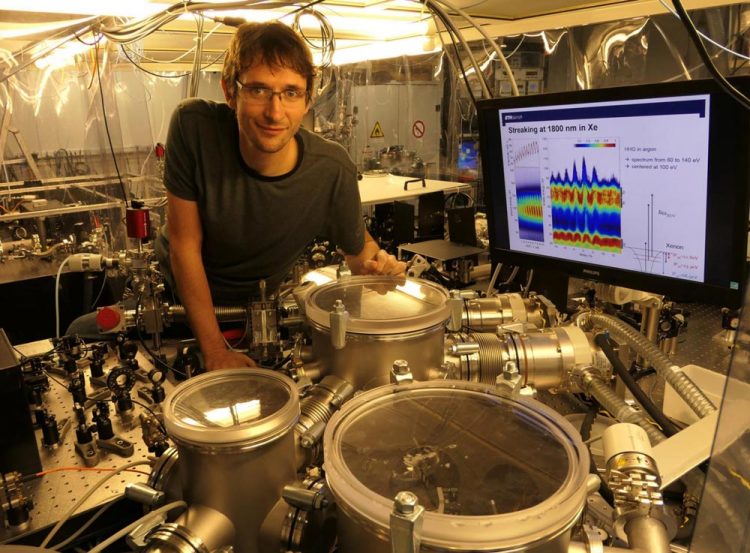The world's shortest laser pulse

Thomas Gaumnitz, postdoctoral fellow in the group of ETH professor Hans Jakob Wörner with the setup that generates the shortest laser pulses in the world. Credit: ETH Zurich
Molecules rotate in the range of picoseconds (10-12 s), their atoms vibrate in the range of femtoseconds (10?15 s), and the electrons move in the range of attoseconds (10-18 s). ETH professor Hans Jakob Wörner and his group have now succeeded in generating the world's shortest laser pulse with a duration of only 43 attoseconds.
More generally speaking, this laser pulse is the shortest controlled event that has ever been created by humans. The researchers can now observe in high detail how electrons move within a molecule or how chemical bonds are formed.
Breaking down transition states
Starting from an infrared laser, the researchers generate a soft X-ray laser pulse with a very large spectral bandwidth. As a result, various elements including phosphorus and sulphur can be directly observed by exciting their inner-shell electrons. Both elements are present in biomolecules, and it is now possible to observe them with unprecedented time resolution.
But what is the advantage of being able to observe the reaction steps now with even higher resolution? “The faster a charge transfer can take place, the more efficiently a reaction can proceed”, says Prof. Wörner. The human eye for example is very efficient when it comes to converting photons into nerve signals.
In rhodopsin, a visual pigment in the retina, the photosensitive molecule retinal is prearranged in such a way that its structure can change extremely fast through the absorption of only a single photon. This enables the visual process even in twilight. A much slower reaction would render vision impossible, because the energy of the photon would be converted to heat in only a few picoseconds.
Attosecond spectroscopy could contribute to the development of more efficient solar cells since it is now for the first time possible to follow the process of excitation through sunlight up to the generation of electricity step by step. A detailed understanding of the charge transfer pathway could help optimizing the efficiency of the next generation of photosensitive elements.
Optical manipulation of the reaction process
Attosecond laser spectroscopy is not only suitable for mere observation, Prof. Wörner explains. Chemical reactions can also be directly manipulated: Using a laser pulse can alter the course of a reaction – even chemical bonds can be broken by stopping the charge shift at a certain location in the molecule. Such targeted interventions in chemical reactions have not been possible until now, since the time scale of electron movement in molecules was previously unreached.
The group of Prof. Wörner is already working on the next generation of even shorter laser pulses. These will make it possible to record even more detailed images, and thanks to a wider X-ray spectrum even more elements can be probed than before. Soon it will be possible to follow the migration of electrons in more complex molecules with an even higher time resolution.
###
Reference
Gaumnitz T, Jain A, Pertot Y, Huppert M, Jordan I, Ardana-Lamas F, Wörner HJ. Streaking of 43-attosecond soft-X-ray pulses generated by a passively CEP-stable mid-infrared driver. Optics Express, Vol. 25, Issue 22 (2017) doi: 10.1364/OE.25.027506
Media Contact
All latest news from the category: Physics and Astronomy
This area deals with the fundamental laws and building blocks of nature and how they interact, the properties and the behavior of matter, and research into space and time and their structures.
innovations-report provides in-depth reports and articles on subjects such as astrophysics, laser technologies, nuclear, quantum, particle and solid-state physics, nanotechnologies, planetary research and findings (Mars, Venus) and developments related to the Hubble Telescope.
Newest articles

Properties of new materials for microchips
… can now be measured well. Reseachers of Delft University of Technology demonstrated measuring performance properties of ultrathin silicon membranes. Making ever smaller and more powerful chips requires new ultrathin…

Floating solar’s potential
… to support sustainable development by addressing climate, water, and energy goals holistically. A new study published this week in Nature Energy raises the potential for floating solar photovoltaics (FPV)…

Skyrmions move at record speeds
… a step towards the computing of the future. An international research team led by scientists from the CNRS1 has discovered that the magnetic nanobubbles2 known as skyrmions can be…





















